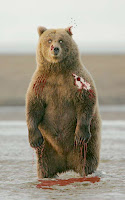

The piece to the bottom right is by Johannes Baargeld entitled, Ordinäre Klitterung: Kubischer Transvestit vor einem vermeintlichen Scheideweg (Vulgar Mess: Cubistic Transvestite at an Alleged Crossroads), 1920. Barrgeld used both photomontage and collage in this work. It looks as if he began with the photograph of the lady, then cut and pasted the two other figures. The two figures in the foreground look as though they are people of high status, people who had traditional values that the Dadaists were trying condemn. In the background, there seems to be a drawing of a military officer pasted. Placing this image within images of properly posed people was probably an assault on the war. The collaged "cubists" shapes add another element in this work by Baargeld. These drawings, which look as if they are from a mathematics textbook, probably are trying to substitute the use of a paint and brush. Baargeld probably meant to mimic the cubist painting movement going on around this time. These shapes are collaged and placed in areas that are meant to be strange and shock the viewer.
Le Roi rouge (The Red King), 1920 is by both Johannes Baargeld and Max Ernst. They used the Dada techniques of overpainting in this particular work. Wallpaper is the used as the surface in which to draw the image in ink. Instead of using a canvas or regular drawing paper, this Dada technique questions the use of everyday material. Why use a canvas, when it is easier to make use of accessible wallpaper? The image painted on the wallpaper looks like a complicated clock system. French words, including "the red king" are labeling the areas on the clock. This could be another techniques used by dadaists called typography. The labels might be metaphors that criticize some area of modern life.

